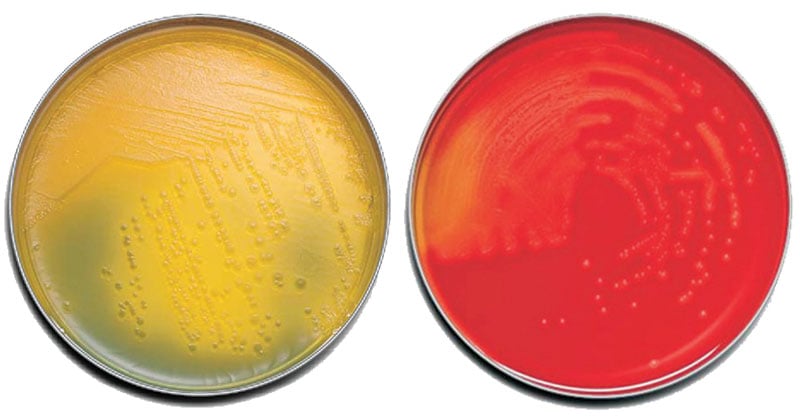Tryptic Soy Agar is used as a general growth medium for the isolation and cultivation of microorganisms. They are general-purpose, non-selective media providing enough nutrients to allow for a wide variety of microorganisms to grow. This medium is also recommended for use in the cultivation, storage, maintenance, and transportation of pure cultures of microorganisms.

Image Source: Thermo Fisher
Interesting Science Videos
Composition of Tryptic Soy Agar
| Ingredients | Gms/liter |
| Pancreatic digest of casein | 17.000 |
| Papaic digest of soybean meal | 3.000 |
| Sodium chloride | 5.000 |
| Dextrose (Glucose) | 2.500 |
| Dipotassium hydrogen phosphate | 2.500 |
| Agar | 15.000 |
Final pH (at 25°C): 7.3±0.2
Principle of Tryptic Soy Agar
Pancreatic digest of casein and papaic digest of soybean meal provides nitrogen, vitamins, and minerals. This makes it suitable for the growth of a wide variety of fastidious and non-fastidious microorganisms. Glucose serves as a carbohydrate source. Phosphate buffers the media. Sodium chloride maintains the osmotic balance. Agar is the solidifying agent.
The medium may be supplemented with blood to facilitate the growth of more fastidious bacteria or antimicrobial agents to permit the selection of various microbial groups from pure microbiota. As with any media, minor changes may be made to suit specific circumstances.
Preparation and Method of Use of Tryptic Soy Agar
- Suspend 45 grams in 1000 ml distilled water.
- Heat to boiling to dissolve the medium completely.
- Sterilize by autoclaving at 15lbs pressure (121°C) for 15 minutes.
- Cool to 45-50°C.
- Mix well and pour into sterile Petri plates.
- Plates should be warmed to room temperature and the agar surface should be dry prior to inoculating.
- Inoculate and streak the specimen as soon as possible after collection.
- If the specimen to be cultured is on a swab, roll the swab over a small area of the agar surface.
- Streak for isolation with a sterile loop.
- Incubate plates aerobically at 35-37°C for 18-24 hours (some organisms may take longer than 24 hours for visible growth to appear).
- Examine for colonial morphology.
Result Interpretation on Tryptic Soy Agar
| Organisms | Growth |
| Aspergillus brasiliensis | Positive |
| Candida albicans | Positive |
| Staphylococcus aureus | Positive; pigmented shiny round colonies |
| Staphylococcus epidermidis | Positive |
| Bacillus subtilis | Positive; flat, large irregular colonies |
| Pseudomonas aeruginosa | Positive |
| Escherichia coli | Positive; shiny round colonies |
| Salmonella Typhimurium | Positive |
Uses of Tryptic Soy Agar
- The medium is used for a wide range of applications, including culture storage, enumeration of cells (counting), isolation of pure cultures, or simply general culture.
- Tryptic Soy Agar supports the growth of a wide variety of organisms including fastidious and non- fastidious such as Neisseria, Listeria, and Brucella, etc.
- Tryptone Soya Broth with added dextrose, sodium chloride, and agar is recommended for the cultivation of Salmonella Typhi.
- TSA is frequently the base medium of other agar plate types. For example, blood agar plates (BAP) are made by enriching TSA plates with defibrinated sheep blood, and chocolate agar is made through additional cooking of BAP.
- It can be used to determine, X, V, and XV factor in Hemophilus species using strips that have the factors X, V, and XV in the inoculated plates.
- Tryptic soy agar with the addition of salt can be helpful in determining the halotolerance level of microorganisms.
- It is commonly used for environmental testing in the pharmaceutical field.
- It is helpful in testing water, cosmetics, industrial, food, and beverages.
- Tryptic Soy Agar may also be used as a medium for maintaining or subculturing reference strains, e.g., Enterobacteriaceae and staphylococci.
Limitations of Tryptic Soy Agar
- It is recommended that biochemical, immunological, molecular, or mass spectrometry testing be performed on colonies from pure culture for complete identification.
- The application of tryptic soy agar in microbiology is limited because it does not promote the growth of some types of fastidious bacteria on its own.
- It cannot be used to isolate pathogens from clinical specimens.
References
- http://himedialabs.com/TD/M1968.pdf
- https://www.sciencedirect.com/topics/immunology-and-microbiology/trypticase-soy-agar
- https://www.sigmaaldrich.com/catalog/product/sial/22091?lang=en®ion=NP
- https://www.atcc.org/~/media/F11236DC0E36489ABFA10BF4A411C525.ashx
- https://www.bd.com/resource.aspx?IDX=30530
- https://www.dalynn.com/dyn/ck_assets/files/tech/PB81.pdf

do you have any procedure in bacillus subtilis using TSA? thank you
thanks for the information, will feed you back when i try it
this information is very important